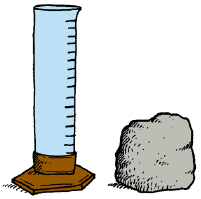Yellow
Green
Blue
Red
Magenta
Remove
Check-In: Questions 13–16
Show or tell how to use the graph and ratios to solve each problem.
- Suppose you wanted to find the volume of a lump of clay that was too big to fit in your graduated cylinder. How can you use your two-pan balance to help find its volume?
- Maria put a mystery object in a box. She told the class it had a mass of 30 g and a volume of 6 cc. Was it steel, clay, or a third material?
- A piece of clay has a volume of 100 cc. Find its mass.
- A piece of steel has a mass of 1500 g. Find its volume.


Patterns with Graphs: Sink and Float

- Use your data from the Sink and Float lesson to graph the mass vs. volume line for each of the objects in that lesson. Be sure to include the line for water. The line for each object will go through the point (0, 0) and that object's data point. Romesh's line for a rock is shown at the right.
- Make one line for each object.
- Label each line with the name of the object.
- Indicate whether the object sinks or floats by labeling its line with “ S ” or “ F. ”













